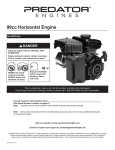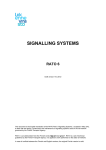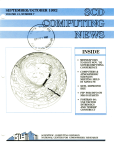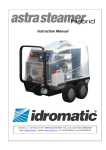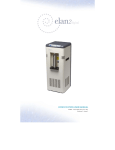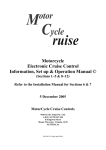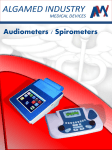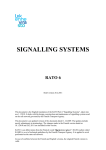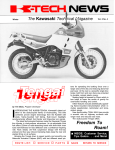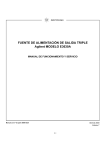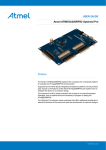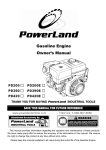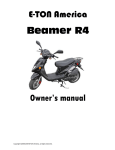Download 90 & 100 Riders Handbook.indd
Transcript
Foreword We wish to thank you for your choosing this fine Kawasaki Motorcycle. With the proper care and maintenance you will find your ”dynamic partner” will go any time and anywhere. Please read this handbook carcfully to obtain instuctions for proper use of your motorcycle, so that you can always enjoy its best performance. This handbook has been painstakingly reconstructed by D.A.S.ENgineering of Sweden to exactly resemble the original. The variations of fonts, kerning and strange spacing are all fully intentional and follow the original design. KAWASAKI HEAVY INDUSTRIES, LTD. Motorcycle Division Contents Foreword .......................................................................... 1 1. Illustrations .................................................................. 4 2. Specifications ............................................................... 6 3. Stopping Distance and Passing Time ............................ 10 (Consumer Information) 4. Breaking In.................................................................... 13 5. Controls ........................................................................ 15 Fuel Tap .................................................................. 15 Starter Lever ........................................................... 15 Clutch Lever ........................................................... 16 Gear Change Pedal .................................................. 16 Brakes ..................................................................... 17 2 6. Starting the Engine ....................................................... 18 7. Parking ......................................................................... 19 8. Maintenance and Adjustments ................................. 20 Electrical System ................................................. 20 Carburetor ........................................................... 24 Control Cable ...................................................... 24 Brakes ................................................................. 26 Tires .................................................................... 27 Clutch .................................................................. 28 Drive Chain ......................................................... 29 Air Cleaner .......................................................... 30 Muffler ................................................................ 31 9. Tool Kit ................................................................... 32 10. Daily Checks ........................................................... 32 11. Periodical Inspection Chart ..................................... 33 12. Wiring Diagram ....................................................... 34 3 90 G3SS 4 90-SS GA2-A 100 GA5-A 90 GA1-A 5 2. Specifications Engine G3SS Type .................................. 2-stroke, rotary valve, single cylinder, air cooled Displacement ..................... 5.43cu-in (89cc.) Bore X Stroke .................... 1.85X2.04in (47X51.8mm) Comprcssion Ra.tio 7.0:1 Fuel ................................... Gasoline Ignition ............................. Fly-wheel magneto Ignition Timing ................. 20° Before TDC Starting ............................. Primary Kick Lubrication ....................... Superlube (Oil injection) Engine Oil ......................... 2-stroke engine oil Carburetor ......................... Mikuni VM19SC Spark Plug ......................... NGK B-8HC Performance Max, Torque ...................... Max. Speed ....................... Climbing Ability ................ Minimurn Turning Radius .. Fuel Consumption .............. Transmission 7.10ft-lb (0.98kg-m)/7,000rpm 70mph (113kph) 27° 71.0in (1,800mm) 171mi/gal@25mph (75km/l@40kph) Type .................................. 5-speed, constant mesh, return shift Clutch ................................ Wet multi-plate Primary Reduction Ratio .... 3.52 (74/21) Final Reduction Ratio ........ 2.64 (37/14) 6 GA5-A 6.04cu-in (99cc.) 1.95X2.04in (49.5X51.8mm) NGK B-8HC 7.95ft-lb (1.10kg-m)/7,000rpm 70mph (113kph) 29° 160mi/gal@25mph (70km/l@40kph) 2.57 (36/14) G3SS Transmission Oil SAE 20,30 motor oil (0.74qt) Type ..................................... Suspension, Front ................. Rear ...................................... Tire Size, Front ..................... Rear ...................................... Tubular, double cradle Telescopic fork Swinging arm 2.75-18 4PR 2.75-18 4PR Frame Brakes GA5-A 2.50-18 4PR 2.75-18 4PR Front, Diameter X Width ....... 4.3X1.2in (110X30mm) Rear, Diameter X Width ....... 4.3X1.2in (110X30mm) Braking Distance .................. 21ft/22mph (6.5m/35kph) Electrical Equipment Battery ................................. 6V 4AH Head Lamp ........................... 6V, 25/25W Tail/Brake Lamp ................... 6V, 17/5.3W Dimensions Overall Length ..................... Overall Width ....................... Overall Height ...................... Wheelbase ............................ Ground Clearance ................. Dry Weight ........................... Fuel Tank Capacity ............... Oil Tank Capacity ................. 72,0in (1,830mm) 33.1in ( 840mm) 40.5in (1,035mm) 45.3in (1,150mm) 6.5in ( 160mm) 178lbs (81kg) 2.3 US gal (8.6liters) 11/4 U.S.qt. (1.2liters) 174lbs (79kg) *Specifications subject to change without notice 7 Engine Type ................................... Displacement ...................... Bore X Stroke ..................... Comprcssion Ra.tio Fuel ..................................... Ignition ............................... Ignition Timing ................... Starting ............................... Lubrication .......................... Engine Oil ........................... Carburetor ........................... Spark Plug ........................... Performance Max, Torque ........................ Max. Speed .......................... Climbing Ability .................. Minimurn Turning Radius .... Fuel Consumption ............... Transmission Type ................................... Clutch ................................. Primary Reduction Ratio ..... Final Reduction Ratio .......... 8 GA-1A 2-stroke, rotary valve, single cylinder, air cooled 5.43cu-in (89cc.) 1.85X2.04in (47X51.8mm) 7.0:1 Gasoline Fly-wheel magneto 20° Before TDC Primary Kick Superlube (Oil injection) 2-stroke engine oil Mikuni VM19SC NGK B-7HZ 7.08ft-lb (0.98kg-m)/7,000rpm 62,5mph (100kph) 29° 70.9in (1,800mm) 171mi/gal@25mph (75km/l@40kph) 4-speed, constant mesh, return shift return shift Wet multi-plate 3.52 (74/21) 2.79 (39/14) GA2-A 69mph (110kph) 27° 176mi/gal@25mph (75km/l@40kph) 5-speed, constant mesh, 2.54 (36/14) GA-1A Transmission Oil SAE 20-30 motor oil (0.74qt) Type .................................... Suspension, Front ................. Rear...................................... Tire Size, Front .................... Rear ..................................... Tubular, double cradle Telescopic fork Swinging arm 2.50-18 4PR 2.50-18 4PR Front, Diameter X Width ..... Rear, Diameter X Width ...... Braking Distance .................. 4.3X1.2in (110X30mm) 4.3X1.2in (110X30mm) 21,3ft/22mph (6.5m/35kph) Battery ................................ Head Lamp .......................... Tail/Brake Lamp .................. 6V 4AH 6V, 25/25W 6V, 5.3/17W Overall Length ..................... Overall Width ...................... Overall Height ..................... Wheelbase ........................... Ground Clearance ................. Dry Weight .......................... Fuel Tank Capacity .............. Oil Tank Capacity ............... 71.3in (1,810mm) 29.1in ( 740mm) 40.2in (1,020mm) 45.5in (1,150mm) 5.9in ( 150mm) 174lbs (79kg) 2.3 US gal (8.6liters) 11/4 U.S.qt. (1.2liters) Frame Brakes Electrical Equipment Dimensions GA2-A *Specifications subject to change without notice 9 3. Stopping Distance and Passing time Information) VEHICLE MINIMUM STOPPING DISTANCE ON DRY PAVEMENT This figure indicates braking performance that can be met or exceeded by the vehicles to which it applies, without locking the whee1s, under different conditions of loading. The inforniation presented represents results obtainable by skilled drivers under controlled road and vehicle conditions. a.nd the information may not be correct under other conditions. Description of vehicles to which this table applies: 90 Model G3SS. Fully Operational Service Brake Load: Light 170 Maximum 174 0 10 50 100 150 200 Stopping Distance in Feet from 60 mph. G3SS 250 ACCELERATION AND PASSING ABILITY T H I S F I G U R E I N D I C AT E S PA S S I N G T I M E S A N D D I S TA N C E S T H AT C A N B E M E T O R E X C E E D E D B Y THE VEHICLES TO WHICH IT APPLIES, IN THE SITUATIONS DIAGRAMMED BELOW. THE LOW-SPEED PASS ASSUMES AN INITIAL S P E E D O F 2 0 M P H A N D A L I M I T I N G S P E E D O F 3 5 M P H . THE HIGH-SPEED PASS ASSUMES IN INITIAL S P E E D O F 5 0 M P H A N D A L I M I T I N G S P E E D O F 8 0 M P H . NOTICE: THE INFORMATION PRESENTED REPRESENTS RESULTS OBTAINABLE BY SKILLED DRIVERS U N D E R C O N T R O L L E D R O A D A N D V E H I C L E C O N D I T I O N S , A N D T H E I N F O R M AT I O N M AY N O T BE CORRECT UNDER OTHER CONDITIONS. DESCRIPTION OF VEHICLES TO WHICH THIS TABLE APPLIES: Model G3SS SUMMARY TABLE G3SS LOW-SPEED PASS......... 440 FEET: 10.3 SECONDS HIGH-SPEED PASS........ 1615 FEET: 18.6 SECONDS 11 12 4. Breaking In This Kawasaki motorcycle is precision manufactured, but it must be broken in properly for the first 1,000 miles (1,600 km.) to ensure long and troublefree service life. Superlube Oil Injection System Your Kawasaki is equipped with Superlube oil injection which elirninates the need to mix oil with the gas. Check the level in the oil tank regularly. Add one quart of oil when the level falls to the line on the tank guage. Never let the tank run dry. Do not disconnect the oi1 pipe to the engine as this may cause an air 1ock leading to engine damage. Use any good quality two (2) cycle oil designated for use in motorcycles or air cooled engines. Racing type oils are not required tor normal riding conditions. Your dealer can recommennd oils most suitable and available in your area. Avoid use of oils which do not flow readi1y at low temperatures, as these wil1 not f1ow to the oil pump in the proper quantity in cold weather. Do not attempt to adjust the oil pump yourselt. When adjustment is required, consult your Kawasaki dealer. 13 Fig. 1 G3SS Adding and Changing Transmission Oil Check the oil level daily and never let it drop below the mark on oil level gauge (dip stick). Change the transmission oil at 500 miles (800 km), and at every 2,000 miles (3,000 km) after that. Drain the oil when the engine is warm, and refill with good quality SAE 20or30 motor oil. To fi1l the transmission, remove the oil filler cap and fill until the oi1 level is between the two lines marked on the level gauge, when the gauge is screwed in. Do Not ”Race” Engine Fig. 2 Do not race the engine or run at high revs immediately after starting. Over revving the engine in neutral can cause severe engine damage. Do Not Overspeed Oil Level 14 Fig. 3 Ride the motorcycle at 35 mph (55 kph or slower) the first 300 mi (500 km). Even after that, do not strain the engine by running it at high speeds. In particular. be carefuI not to run the engine at high speeds with the gears in neutral, as this overloads turning parts and can cause defective engine operation. Do not brake the motorcycle suddenly, do not strain the engine and do not slip the clutch (half clutch). Note: Allow engine to warm up thoroughly at idling speed for 2 ~ 3 minutes before riding, to let the oil reach the engine. 5. Controls Fuel Tap Fuel tap lever position ”0” is closed, ”1 ” is open, and ”2” opens a reserve supply of about I/8 US-gal (0.5 liter). Fig. 4 Every 2.000 miles (3,000 km), reove the bowl from the bottom of the fuel tap, clean the fuel tap filter and flush the gas tank. Starter Lever Use the starter lever when the engine is cold. Push the lever all the way to the left to supply an extra rich fuel air mixture, keep the throttle closed and kick the starter pedal through smartly. Be sure to pull the starter lever back to the right to its normal positon after the engine warms up. Fig. 5 15 Clutch Lever The clutch lever operates the clutch. When the lever is pulled in, engine power is not tramitted to the rear wheel. When the Iever is released, power is supplicd to the rear wheel and the motorcycle moves. Pull in the lever quickly and release it slowly. Gear Change Pedal Transmission gears are changed by kicking up the gear change pedal. GA1-A Fig. 6 16 The 4-speed transmission is of rotary shift type, so the gears are changed with eitlier the front or rear of the gear shift pedal. Step on the front of the pedal to shift into a higher gear, and on the rear of the pedal to shift into a lower gear. When the grears are in neutral (between low and top gear), engine power cannot be transmitted to the rear wheel and the green neutral lamp in the speedometer lights. Gear sequence is: neutral (green lamp on), first, second, third, fourth, neutral (green lamp on), etc. GA2-A, G3SS, GA5-A Fig. 7 The 5-speed transmission is a stopper type, return change. Neutral is located at the lowest position, so the gears can be shifted up by lifting the pedal up with the toe, and shifted down into a lower gear by stepping on the pedal. When the gears are in neutral, engine power cannot be transmitted to the rear wheel and the green neutral lamp in the speedometer lights. Gear sequence is as fol1ows: Neutral (green lamp on), first, second, third, fourth, fifth. Brakes The motorcycle will stop smoothly and safely when both front and rear brakes are applied at the same time. The rear brake operates when the brake pedal is pushed by the right foot. The front brake operates when the brake lever on the handlebar is pulled in with the right hand. Fig. 8 17 6. Starting the Engine Starting is by thc primary kick system, so the engine can be started by pulling up the clutch lever and kicking the pedal, regardless of gear position. Cold Engine Fig. 9 19 Fig. 10 This Kawasaki motorcycle has carburetor starter system for easy starting even when cold. 1. Open fue1 cock. If fuel does not flow to carburetor, turn fuel cock lever to open reserve supply. 2. Push carburetor starter Iever a11 the way to the Ieft. 3. Close thrott1e completely. If the throttle is open even a little, the carburetor starter systern will not work effectively, and the engine will be hard to start. 4. Insert key in ignition switch and turn it on. 5. Squeeze the clutch lever. 6. Kick the starter pedal down smartly. 7. After the engine starts, twist the throttle grip open just a little. When engine speed increases, indicating the engine has warmed up, return the starter lever to its normal position. If the starter lever is not returned to its normal position, too rich a mixture is supp1ied to the engine, causing fou1ed spark plug and defective engine operation. Warm Engine Do not use the starter 1ever when the engine is warm, or the engine may be flooded or the spark plug fouled. 1. Open fuel cock. 2. Insert key in ignition switch and turn it on. 3. Squeeze the clutch lever. 4. Crack the throttle open a little, about 0 ~ 1/ 4 turn. 5. Kick the starter pedal down smartly, and the engine will start. Note: At night, start the engine first and then turn on the head lamp after the engine is running. 7. Parking Shift the gears into neutral and stop the engine. Rest the motorcycle on either the side stand or the main stand. Close the fuel cock. Remove the key from the ignition switch. Lock the steering lock. Fig. 11 19 8. Maintenance and Adjustments Electrical System Adjusting Ignition Timing Fig. 12 20 Fig. 13 Rotate flywheel (A) until mark (B) on the outside of the flywheel coincides with mark (C) on the crankcase. Loosen fitting screw (D) and move the contact breaker assembly to the right or left by turning a screwdriver in the slots on the contact breaker base (F) and on the contact breaker assembly (G), until the contact points are just about to open. Tighten mounting screw (D) securely. After adjusting, turn the engine in the running direction with the ignition switch turned off, by using the kick pedal, or a wrench on the nut on the end of the crankshaft. The contact points should just begin to open when mark (B) on the outside of the flywheel coincides with mark (C) on the crankcase (20° before top dead center). Spark Plug Use only a NGK B-7HZ spark plug or a plug of equivalent heat range and reach, as the spark plug and its condition directly affect engine performance. Fig. 14 It is important that the spark plug be kept in good condition. The spark plug electrodes are subjected to extremcly high temperatures and wear down, necessitating periodic adjustment. Check the plug gap frequently and set it to 0.024” (0.6mm). A spark plug with a gap too large or too small will cause hard starting, misfiring, etc. Clean the spark plug with a wire or brush and wash with gasoline if carbon accumulates on the spark plug electrodes. Dry it completely and insert the spark plug by screwing it down hand tight, then tightening it with a plug wrench. Be sure to insert a spark plug gasket. 21 Battery Fig. 15 22 The battery is important as the electrical source for starting and electrical equipment. If the battery is not given proper care, it will not give satisfactory performance and its life will be short. Be sure to give the battery frequent inspections and proper care at all times. Keep the solution level above the lower line printed on the battery. If the solution level is low, add distilled water only, up to the upper line. Do not add diluted sulphuric acid. Make sure the air vent is kept open. Do not spill the acid. Keep the battery clean. Completely charge the battery before installing it. If the motorcycle is not ridden for more than one month, charge the battery once a month. Be sure the positive and negative terminals are connected to the correct wires. Tighten terminal nuts and bo1ts firmly. Head Lamp Fig. 16 The 6V, 25/25W head lamp is turned on when the ignition switch key is turned to position ”2” for night riding. The head lamp is dimmed with the dimmer switch mounted on the left handlebar. Left or right adjustment is performed by turning the adjuster screw in the front of the headlight. Adjust the beam lower or higher by first loosening the mounting bolts on the sides of the headlight, and moving the light by hand. After adjustment is complete, be sure to retighten the bolts. Fig. 17 23 Carburetor Fig. 18 The carburetor atomizes the gasoline, mixes it with the proper amount of air and supplies it to the engine. To achieve correct carburetor settings, adjust it only when the engine is completely warmed up. The standard setting of the pilot air screw, is 11/ 2 turns backed out from full in. Standard idle speed is 1,300 ~ 1,500 rpm. To adjust idling speed. turn the throttle stop screw out to increase speed, and turn in it to decrease rpm. As incorrect adjustment can cause serious problems, it is best to have your Kawasaki Dealer perform any neccssary adjustment. Control Cable Fig. 19 24 The throttle cable must be synchronized with the oil pump cable, so that the throttle valve of the carburetor opens in accordance with oil pump lever opening. Do not adjust the throttle cable adjusters on the mixing chamber top alone, because since the throttle cable must be synchronized with the oil pump cable, whenever one cable is adjusted the other must be adjusted also, to maintain the correct oil flow rate for each degree of throttle opening. 1. Adjust engine idling speed. (1,300 ~ 1,500 rpm) 2. By turning adjusting bolt (a) on the control cable, give enough play to the cable so that the throttle grip turns loose. Take up all oil pump cable play by turning the oil pump cable adjuster (f), with the mark on the oil pump lever aligned to that on the stopper. 4. Eliminate throttle cable play by turning the cable adjuster (d) on the carburetor. Be sure not to change the idling speed when adjusting the cable. Note: (d), (c) and (e) are the lock nuts of the adjusters. After step 3 and step 4, check the control cable to see that both the throttle and the oil pump cables are pulled up simultaneously. 5. Finally, adjust the control cable play by turning the adjusting bolt and taking up throttle grip play. Fig. 20 25 Brakes Correct brake adjustment is most important for safe riding. Always be sure to check the brakes before riding. Brake play increases gradually with wear, so adjust it regularly. Fig. 21 Rear Brake Adjust brake pedal play to 1 ~ 11/ 4 inches (25 ~ 35 mm) with the brake rod adjusting nut. Check the brake lamp switch adjustment, and adjust it if necessary. Fig. 22 26 Front Brake Using the adjusting nut on the front brake cable, adjust the brake so that when it is fully applied, there is 2 ~ 2 1 / 2 inches (55 ~ 65 mm) space left between the throttle grip and the brake lever, measured near the end of the lever. Use the hand adjuster at the brake lever for minor adjustment later. Fig. 23 Fig. 24 Tires Tire air pressure has a large effect on riding comfort, safety, handling, and the life of the motorcycle and the tires. Check the pressure before riding. Standard air pressure for the front tire is 22 psi ( 1.6 kg/cm 2 ) and for the rear tire 28 psi ( 2.0 kg/cm 2 ). Insufficient tire pressure gives a soft ride but wears the sidewalls of the tires rapidly, and sometimes the tire slips on the rim and tears out the inner tube valve stem. Excessive tire pressure makes riding uncomfortable, increases vibrations, and wears the center of the tread rapidly. An over-inflated tire also tends to skid easily. 27 Clutch Fig. 25 28 Fig. 26 Fig. 27 The clutch friction plates wear and the clutch cable stretches over a long period of riding, so it is necessary to adjust the clutch release mechanism and clutch cable every 2,000 milies (3,000km). Caution: Improper adjustment can cause erratic gear shifting, clutch slippage, or incomplete disengagement (cycle creeps forward while stopped). Loosen the clutch release lever lock nut and back out the adjusting screw one or two turns to where the clutch lever turns freely. Turn the clutch cable adjuster and set the release lever at an 80° angle with the cable. Screw the clutch release lever adjusting screw back in until you feel pressure, and lock it there. Adjust the clutch (hand) lever with the cable adjuster for 1/16 to 1/8 inch (2-3 mm) play before you start to feel clutch spring tension. Use the small hand adjuster for minor corrections while riding. Tighten all lock nuts. Drive Chain Fig. 28 Fig. 29 Fig. 30 If the drive chain is not properly lubricated, the links become stiff, resulting in rapid wear of sprockets and drive chain or power loss, as well as straining the engine. Inspect and lubricate the chain periodically. There should be about 20 mm play (just under 1 inch), measured midway between the sprockets, when the rear wheel is turned arouned to where the chain is tightest. To adjust chain tension, first loosen axle, axle sleeve, and torque link nuts, and then turn the chain adjusters. Be sure the chain adjusters on each side are moved the same amount. After chain adjustment, check the rear brake and brake lamp adjustments, which are changed by chain adjustment. Caution: After adjustment be sure to tighten the axle nut, axle sleeve nut torque link nut. 29 Air Cleaner Fig. 31 30 Fig. 32 A clogged air cleaner restricts the engine’s air intake, decreasing gas mileage and engine power, and causing the spark plug to foul. The filter element must be cleaned at least every 2,000 miles (3,000 km). In dusty areas, the element should be cleaned every 500 miles (800 km) or less. After riding through rain or on muddy roads, the element should be cleaned immediately. To remove the G3SS, GA5-A element for cleaning, loosen the hose clamp, and then unhook the body and pull out the element. To remove the GA1-A, GA2-A element for cleaning, take out the four bolts and remove the cover, then pull out the element. Wash the element, housing and felt pieces with gasoline or solvent and blow them dry. After cleaning, dampen it with a small amount of gasoline/oil mixture (about a 20:1 mixture of gasoline and SAE 30 motor oil). Replace the element after 6,000 miles (10,000 km), after cleaning it 5 times, or if it is damaged. Note: When replacing the element, make sure the sponge fits onto the frame well, and there is no place for unfilted air to enter and wear down the engine. Muffler Remove screw (A) and pull out the baffle tube (B). Clean it with a wire brush and by striking it gently, and wash it with gasoline. If the carbon deposits are too heavy to remove in this manner, burn the carbon off with a torch or by placing the baffle tube in a fire. Fig. 33 Fig. 34 31 9. Tool Kit Tool Bag. 17 X 19 mm Open End Wrench. 10 X 14 mm Open End Wrench. 10 X 13 mm Open End Wrench. Screwdriver Grip. Combination Screwdriver / #2 Phillips Screwsirver. #3 Phillips Screwdriver. Spark Plug Wrench. 1O. Daily Checks Fig. 35 Front Brake ........................................... With brake fully applied, 2 ~ 21/2 inches (55 ~ 65 mm) space left between brake lever and throttle grip. Rear Brake ............................................ Brake pedal play 1 ~ 11/2 inch (25 ~ 35 mm) Fuel Tank .............................................. Capacity 2.3 US gal (8.6 liters) Oil Tank ................................................ Capacity 1.3 US qt (1.2 liters) Transmission Oil .................................. Capacity 0.74 qt (0.7 liters) Front Tire ............................................. Air pressure 22 Psi (1.55 kg/cm2) Rear Tire ............................................... Air pressure 28 Psi (1.97 kg/cm2) Electrical Equipment ............................ Check to see that head lamp, tail lamp brake lamp and horn work. Chromium Plated Parts ......................... Wash, clean and wipe with oily cloth to prevent rusting. Clutch ................................................... Clutch lever play 1/16 ~ 1/8 inch (2 ~ 3 mm) 32 11. Periodical Inspection Chart Item Miles ( km) Change Transmission Oil Clean Air Cleaner Tighten Cylinder Head Bolts Clean Spark Plug, Check Gap Check Ignition timing Inspect Drive Chain Check, Adjust Brakes Tighten Nuts and Bolts Grease Motorcycle Clean Fuel Tap Strainer Check Battery Voltage Replenish Battery Solution Remove Wheels, Clean Brakes Clean Exhaust Pipe and Muffler Wash, Lubricate Drive Chain Check, Adiust Contact Points Check, Tighten Spokes 500 (800) 1,000 (1,600) 2,000 (3,000) Every 2,000 (3,000) 33 34 35 36








































